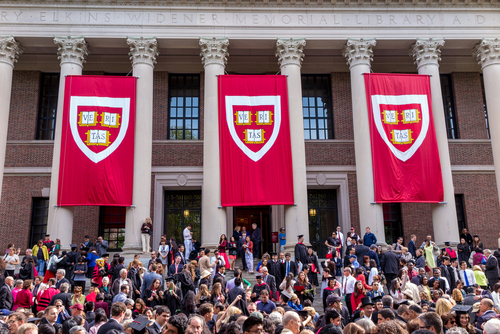WASHINGTON–Today, the U.S. Supreme Court undermined equal opportunity in higher education by holding that the affirmative action plans of Harvard College and the University of North Carolina Chapel Hill violate the Equal Protection Clause.
In Students for Fair Admissions v. University of North Carolina and Students for Fair Admissions v. Harvard College, the Lawyers’ Committee for Civil Rights Under Law along with co-counsel represented multiracial groups of students and alumni from the University of North Carolina at Chapel Hill and Harvard. The Lawyers’ Committee is the only civil rights organization that litigated both cases since their inception and was also the only organization that presented oral argument in the Supreme Court when the cases were argued.
“Through a tortured interpretation of the law, history, and current-day reality, today’s decision threatens to make higher education less accessible, less equitable, and less attainable for students of color,” said Damon Hewitt, President and Executive Director of the Lawyers’ Committee for Civil Rights Under Law. “While seemingly leaving existing precedent undisturbed, the majority’s logic will make it more difficult for all students to have a fair shot at getting the quality education they deserve, especially America’s most marginalized students. This Court is clearly on the wrong side of history. But we will not be deterred, and we will not let this ruling erase our young people’s dreams. We urge every higher education institution to double down on efforts to promote opportunity. And we encourage students to continue talking about their identity and their experiences with race and racism, which even this Court seems to understand still matters. The Lawyers’ Committee is proud to have represented a multi-racial group of students from both UNC Chapel Hill and Harvard. We will continue to support and encourage them to proudly express themselves and their identity–including race. Their experiences and their activism demonstrate the need to keep fighting for equity in higher education and beyond.”
By a 6-3 vote, the Court held that the UNC Chapel Hill and Harvard College affirmative action programs, which consider race as one factor of many as part of a holistic admissions process, violated the Equal Protection Clause. Chief Justice Roberts’ majority opinion did not explicitly overrule the Court’s affirmative action precedents, which the Harvard and UNC were modeled on, or state that race can never be considered as a factor in admissions. But at the same time, the decision pares back the circumstances in which race can be used in higher education admissions. The decision does make it clear that universities can still consider “an applicant’s discussion of how race affected his or her life, be it through discrimination, inspiration, or otherwise.” Justices Sotomayor and Jackson filed separate dissenting opinions. Notably, Justice Sotomayor cited the testimony of several of the Lawyers’ Committee’s student and alumni clients in her dissent about how race was an indispensable part of their identity in stating that universities should be able to consider race as one of many factors in admissions.
“Race-conscious policies were created to mitigate centuries of wrongdoings against people of color and to bring students of all races and backgrounds together. It is one of the greatest ironies that the Court has undermined such policies by holding UNC’s and Harvard’s programs unlawful,” said David Hinojosa, litigator before the Supreme Court and Director of the Educational Opportunities Project. “But we will not be deterred and allow this miscarriage of justice to define our future. The majority of this country are on the side of justice and ensuring opportunity for all. We will pursue every avenue available to ensure our colleges remain open to all and reflect campuses where students’ identities are celebrated not shunned.”
“The Supreme Court’s decision on affirmative action could send a signal to historically marginalized students of color that they are not welcome at many selective colleges,” said Andrew Brennen, UNC Class of 2019 and student intervenor. “College campuses have been integralthroughout history asspaces for progress and movement toward a more just, inclusive society. This decision makes it even harder for universities to provide an enriching educational experience for the entire student population, higher education community, and workforce, which thrives when weembrace our collective diversity. But we will keep fighting for opportunity, just as we have done for generations. We won’t turn back.”
“We often attribute college as a catalyst for success, and beyond that, education as an equalizer of opportunity. Yet, for the majority of the time the American education system has existed, people of color were excluded from educational opportunities granted to their white counterparts, and success was defined by how close to performing whiteness you could be,” said Cecilia Polanco, UNC Class of 2016 and student intervenor. “Today’s opinion is a setback of the progress we’ve made to narrow the persistent racial inequalities that affect students of color. While we move forward in our pursuit of campuses that reflect the diversity of who we are as a country, I can also see a shift in higher education where students of color stop choosing PWIs and elitist schools for the credibility of the name, and instead choose HBCUs and campuses that represent them more and help them feel safe, and return to the teachings of our ancestors.”
“Despite widespread public support – including from a majority of Asian Americans – the Supreme Court undermined one of the most definitive and evidence-based policies to make our education system strong,” said Sally Chen, Harvard Class of 2019 and student intervenor. “This country has a deep history of discrimination and inequities that are inextricably linked to the way our society presently functions. This decision, led by an alarming faction of the Court, comes amid a flood of other attacks on our public education system and diverse democracy. But we have seen that when we join together across races, places, and parties, we can stand up to those who try to divide us. Our work has only just begun.”
###
About the Lawyers’ Committee for Civil Rights Under Law – The Lawyers’ Committee for Civil Rights Under Law is a nonpartisan, nonprofit organization, formed in 1963 at the request of President John F. Kennedy to mobilize the nation’s leading lawyers as agents for change in the Civil Rights Movement. Today, the Lawyers’ Committee uses legal advocacy to achieve racial justice, fighting inside and outside the courts to ensure that Black people and other people of color have the voice, opportunity, and power to make the promises of our democracy real. For more information, please visit https://lawyerscommittee.org


